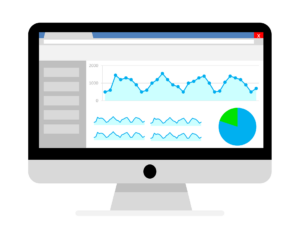Strategy narrows down the path and streamlines the processes. It helps set clear objectives, set priorities, and sequence the steps toward a more organized workflow. Consequently, this hastens the results, makes everyone more efficient, and conserves your resources.
Product strategy helps you set goals, establish the steps for them, and convey the plan to your team. It helps give everyone the same vision and align themselves to it regardless of their role or contribution.
Now, Amazon’s Brand Analytics aids your product strategy in many ways. But overall, it helps you spot opportunities for business growth by providing you with actionable insights based on a lot of data.
This article will tackle the breadth and depth of Brand Analytics and how it can specifically help you increase your sales and expand your business.
What is Amazon’s Brand Analytics?

We all know that Amazon is one of the largest e-commerce platforms in the world, catering to millions of customers every day looking for a variety of products. Being a customer-centric platform, its algorithm is ever-changing to be constantly in tune with consumer needs and behavior. And for sellers, this is somehow challenging to keep up.
Amazon’s Brand Analytics is one of the innovative tools you can use to understand how to cope with the ever-changing landscape of Amazon selling. In essence, it helps the seller understand its customers so it can serve them better. And it can do that by gathering as much data and monitoring insights to spot opportunities as they arise. And that is possible through data analytics and insightful reporting.
Many business decisions rely on data. Before, only large companies, or those Fortune 500, could build infrastructures and systems that can gather and analyze big data to support their decision-making. But as technology continues to progress, even retailers to medium-scale businesses on Amazon can utilize this innovation. All thanks to Brand Analytics.
These data come from your sales history, as well as your competitors and product niche as a whole. It widens your perspective about your product’s performance, as well as suggests ways to help it gain a competitive advantage.
The best thing about Amazon’s Brand Analytics is it is user-friendly. Though it requires a certain learning curve, even small sellers and their little time can understand how to use it.
Here are some ways that sellers can use Brand Analytics with their product strategy:
Identify new product opportunities
Brand Analytics can help you spot gaps in the market, emerging product trends, shifts in customer behavior, and improvements you can make on competitor products. This perspective can already help you even during the product brainstorming phase.
Monitor product performance
You can use data analytics to keep track of the key performance indicators of your product and optimize accordingly. You can see how sales are increasing and decreasing depending on seasons, or tweaks you’ve been making to your product. You can also gather insights from customer reviews, which you can apply to improve your product and customer satisfaction rating.
Track competitor performance
Keeping track of your competitors can also help you improve your own product. You can use the insights to make your product listing better and more compelling to your customers. It can help you strategize on both short-term and long-term goals using competitor analysis.
Analyze consumer behavior
One way to keep the sales up is by making customers happy, leading to repeat purchases and ultimately, loyal customers. Brand Analytics can help you understand your customers – what they want and how they want it delivered. You can improve your product to solve their most concerns.
Optimize product listings
And lastly, analytics can help you with your keyword research not just on the aspect of search volume and relevance but also profitability. This tool is powerful enough to gather and process more data beyond your own products to help you spot opportunities to improve your visibility (or ranking), grow your sales, and increase your profits.
Using Amazon’s Brand Analytics to Optimize Your Product Strategy

Now, just a quick spotlight, branding provides tremendous advantages for sellers, especially in a crowded and competitive marketplace like the internet. And you can also do that in Amazon using tools that are tailored fit to its traffic and competition, or in other words, to its own customer and seller behavior.
And this is what makes Brand Analytics worthy of any seller’s time to do and manage. You get to experience tailored-to-your-success results.
How to Use Brand Analytics to Analyze Product Performance?
Brand Analytics provides different reporting schemes to help you analyze various data and metrics to spot opportunities and areas for improvement for your product listing.
Market Basket Analysis
You can start off by checking the “Market Basket Analysis” tab. It will give you an overview of what products were usually bought together by customers. This is most effective when doing a cross-selling strategy.
Brand Shares
You can also take a look at the “Brand Shares” tab. If you want to see how your product compares to its competitors in the aspect of price, ratings, and search visibility, you can check that here. This can help you have an insight into your product performance and determine areas you can improve.
Demographics
The “Demographics” tab is fitting if you are looking to understand who your customers are. It provides you with information about their ages, gender, and location. This is helpful if you want to optimize your product to fit the needs of the customers you serve to depend on their demographic data.
Search Terms
Now, if you are working on your search visibility or ranking, do not miss the “Search Terms” tab. This is your keyword research tool that allows you to see how customers look for your products and what keywords make them land on your listing. You should be frequenting this report so you can catch up on keyword trends and adjust your PPC campaigns accordingly.
Market Trends
And then, check the “Market Trends” tab if you want to see, in a bigger picture, how the market landscape in your niche changes over time. It enables you to spot impactful developments in your customers’ behavior and the market as a whole. This helps make informed decisions concerning the present and future of your Amazon business.
Now, making data-driven decisions is possible with the help of Brand Analytics. Not only it provides you reports but also actionable insights that you can practically apply to your Amazon business. These reports can definitely help you develop an effective product strategy that can help meet your customers’ needs and outpace your competitors.
Limitations and Challenges of Using Amazon’s Brand Analytics

Access
You have to have your account registered to Amazon’s Brand Registry first to access Brand Analytics.
Data History
Brand Analytics can only utilize up to 90 days’ worth of data. For some niches, it may be insufficient to spot patterns and predict future trends with this.
Data Scope
You can only do competitor analysis with products and competitors that are registered with Amazon.
Limited Insight
Brand Analytics may present different insights into its various categories. You may not get as much with a category that does not receive as much traffic as the others.
Data Analysis Capabilities
Though there’s no question about its purpose and effectiveness as is, sellers looking for complex analysis or cloud computing capabilities that are more appropriate for bigger businesses, need to supplement Brand Analytics with another more sophisticated tool.
Data Security Concerns
It is valid to have some data security concerns since Amazon is an open platform.
Knowing these limitations can help you tweak your product strategy to serve your needs and protect your interest at the same time.
Conclusion
Brand Analytics provides Amazon sellers a bird’s eye view of everything about their businesses. And this can help them successfully launch, grow, and scale in the space. This is made possible by harnessing the power of data that the tool can turn into actionable insights that can help you make data-driven decisions and experience positive results.
Brand Analytics is a must-have for every Amazon seller to help them gain that much coveted “competitive advantage”. And of course, it is essential to optimize every kind of product strategy. It automates some of the processes involved in competitor research and analysis, giving you more time to devote to your other core tasks in growing the business.
If you are not yet using Brand Analytics, start today and gain more control and insight into your Amazon business.

